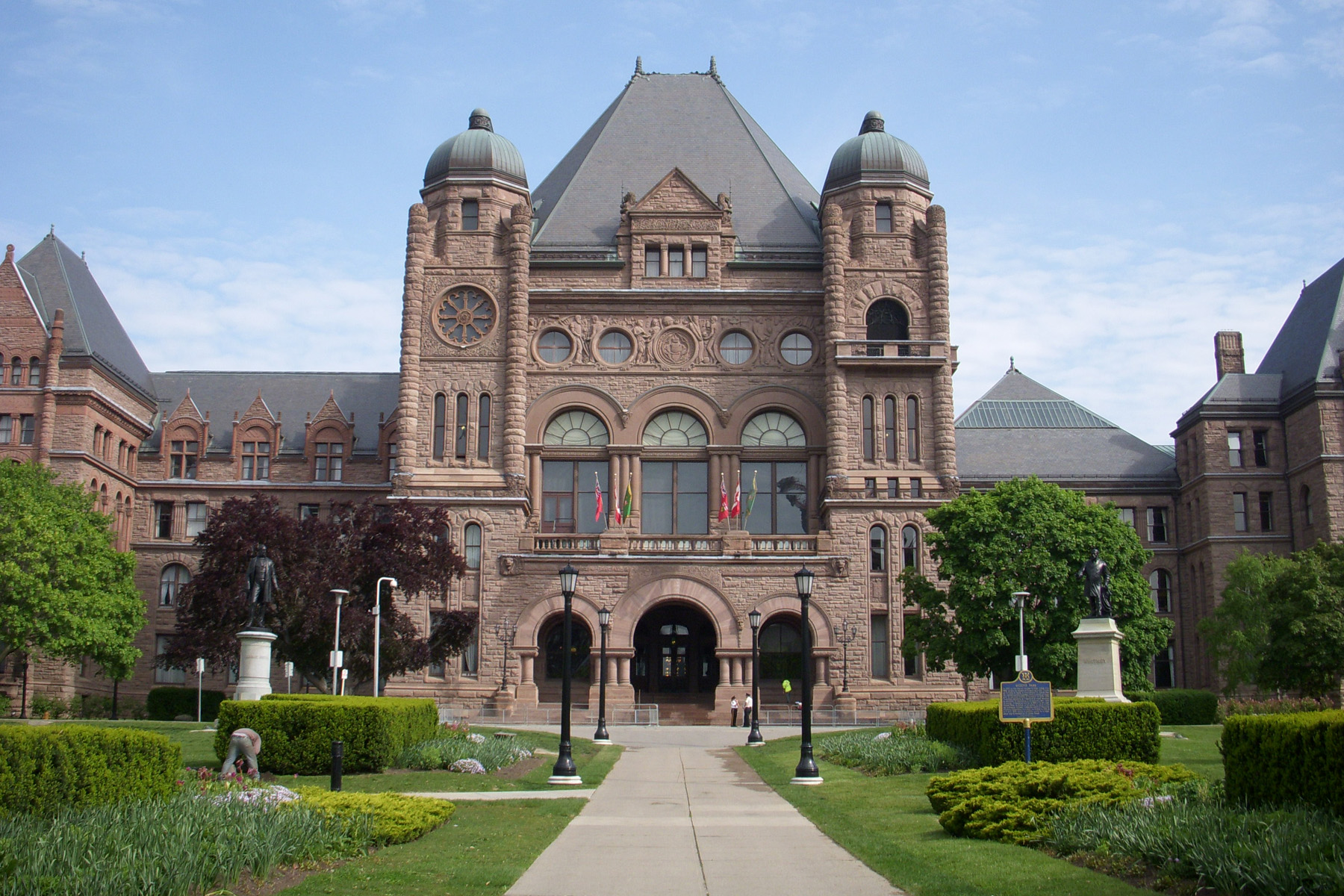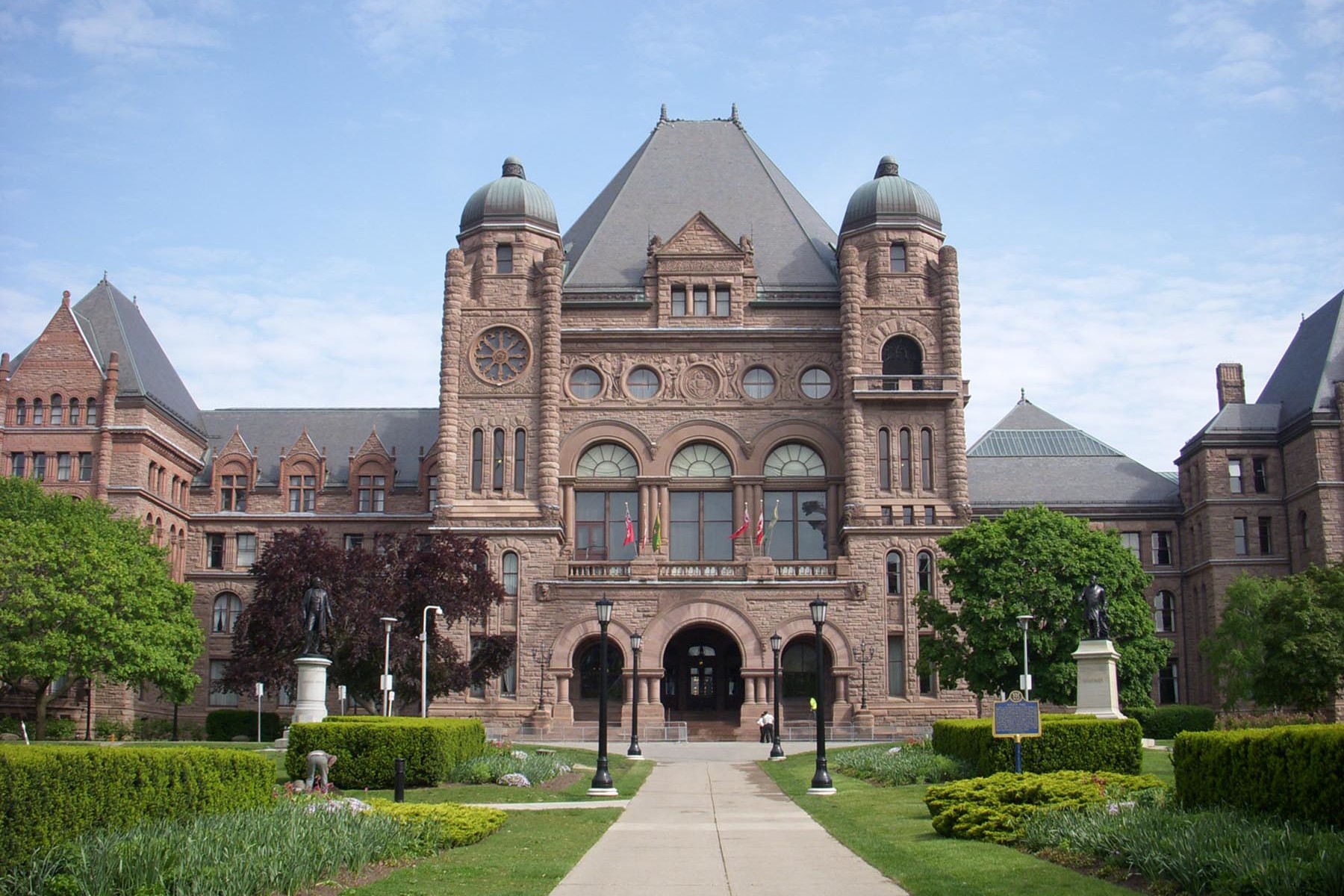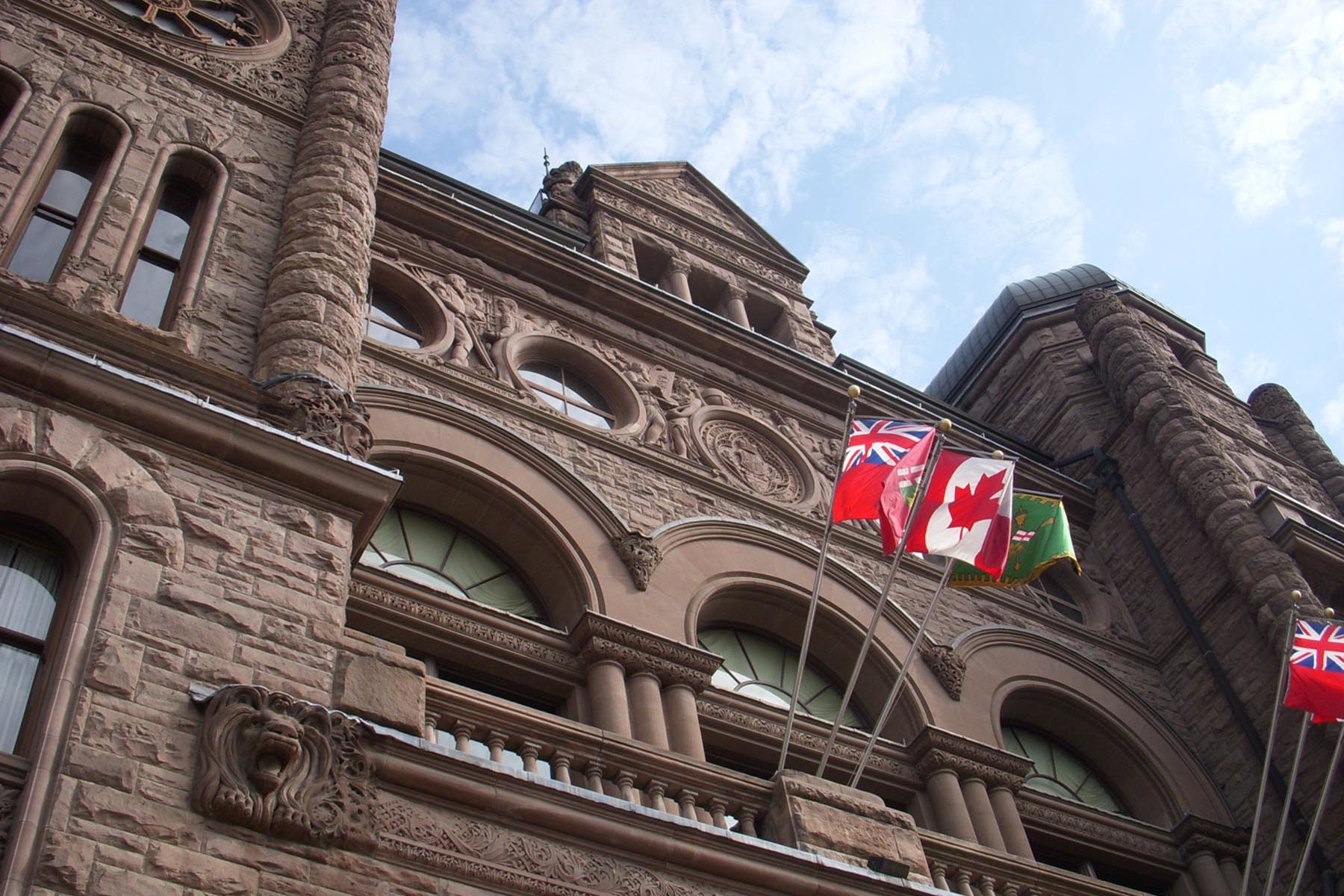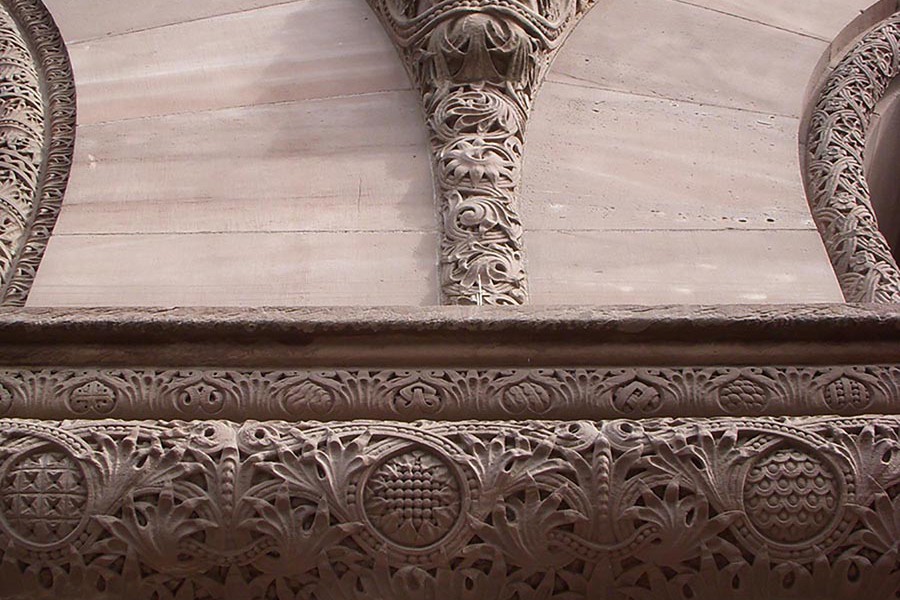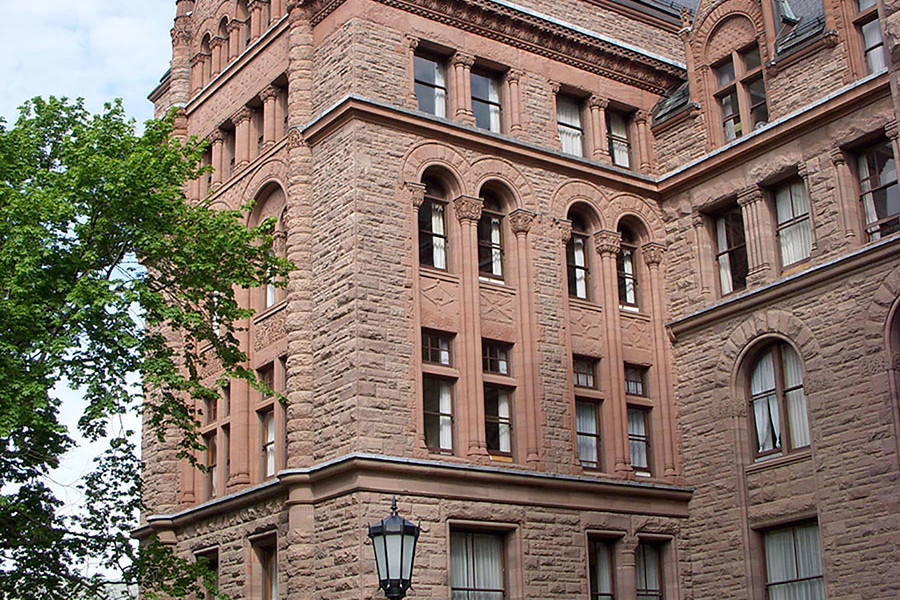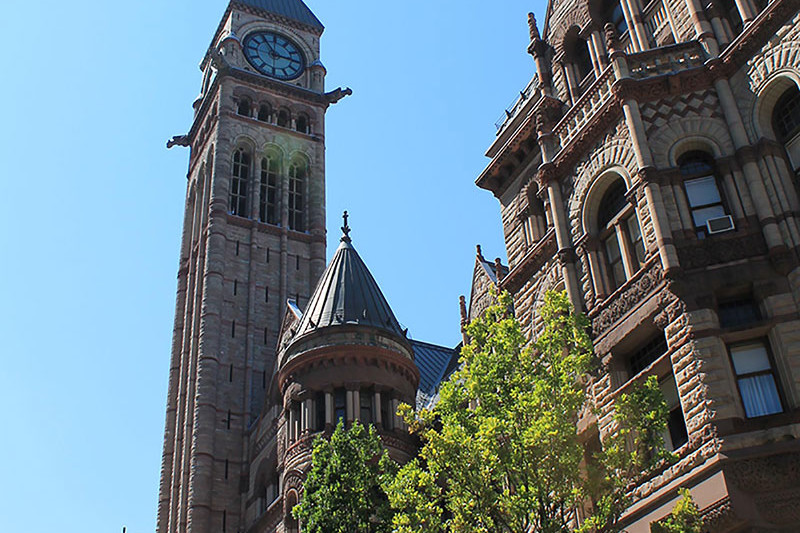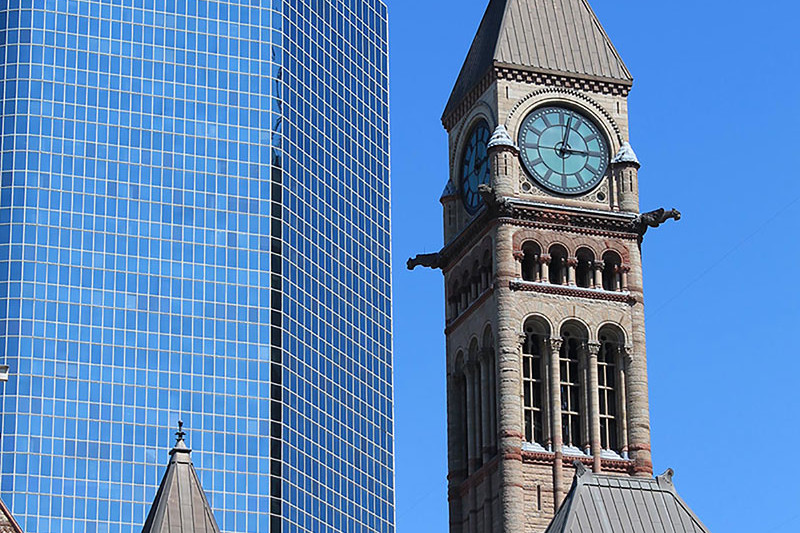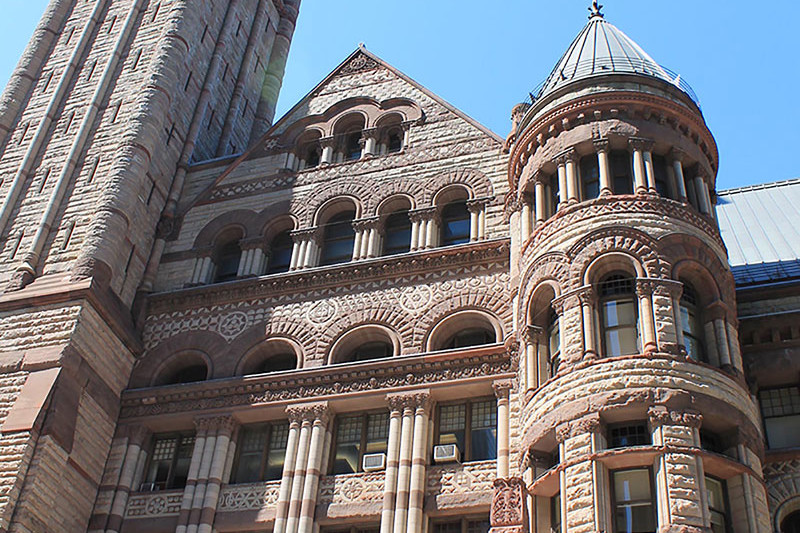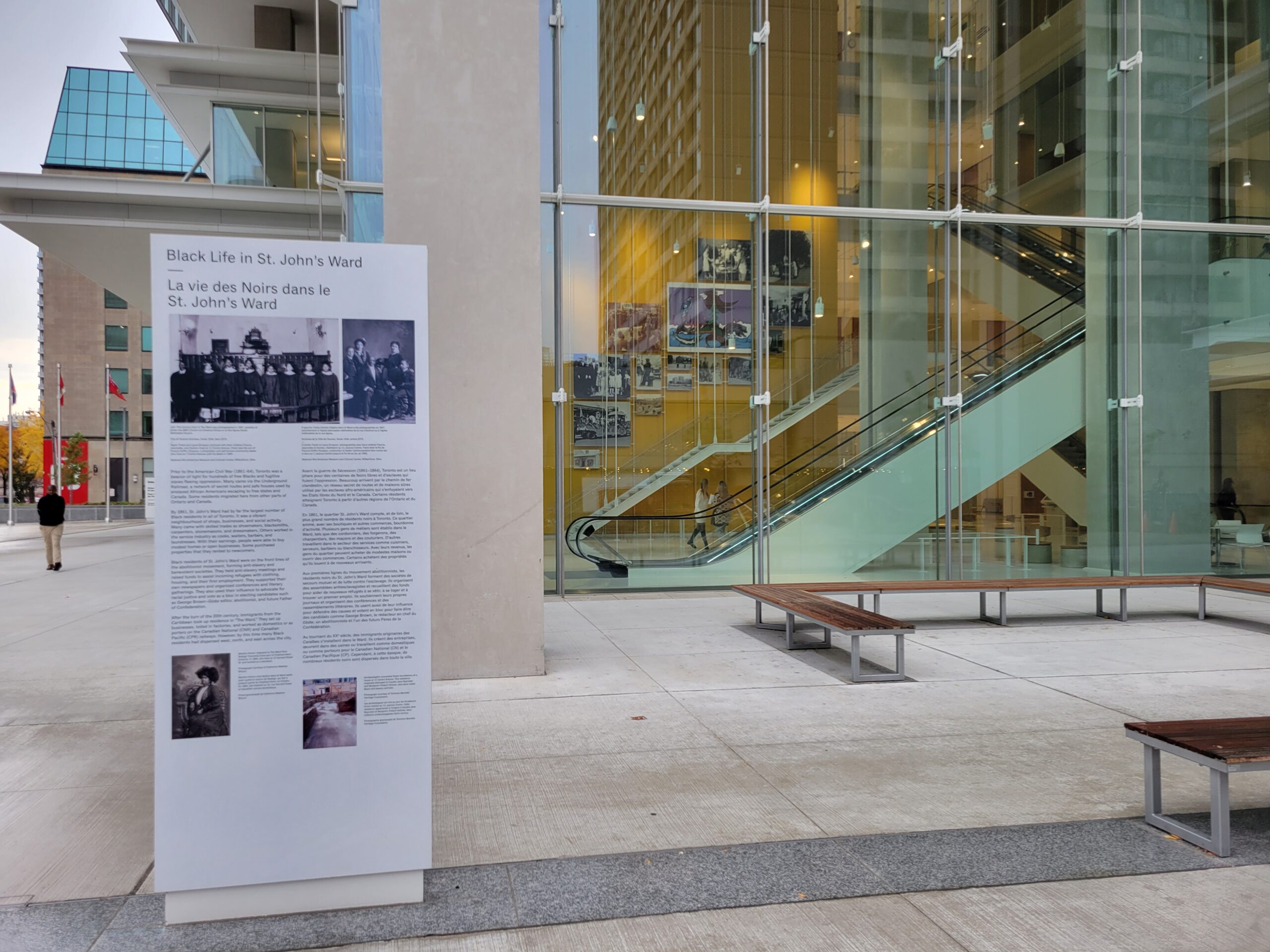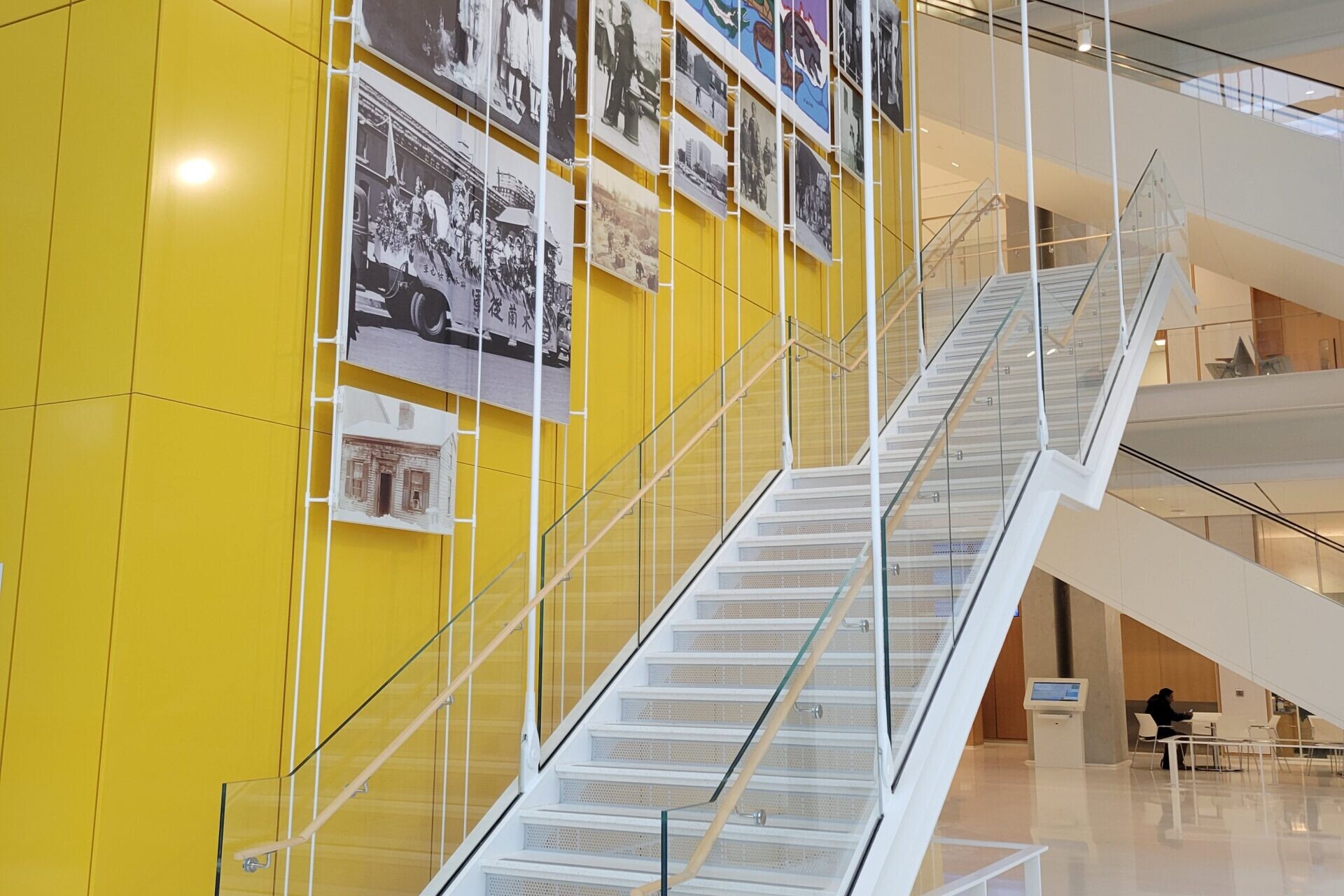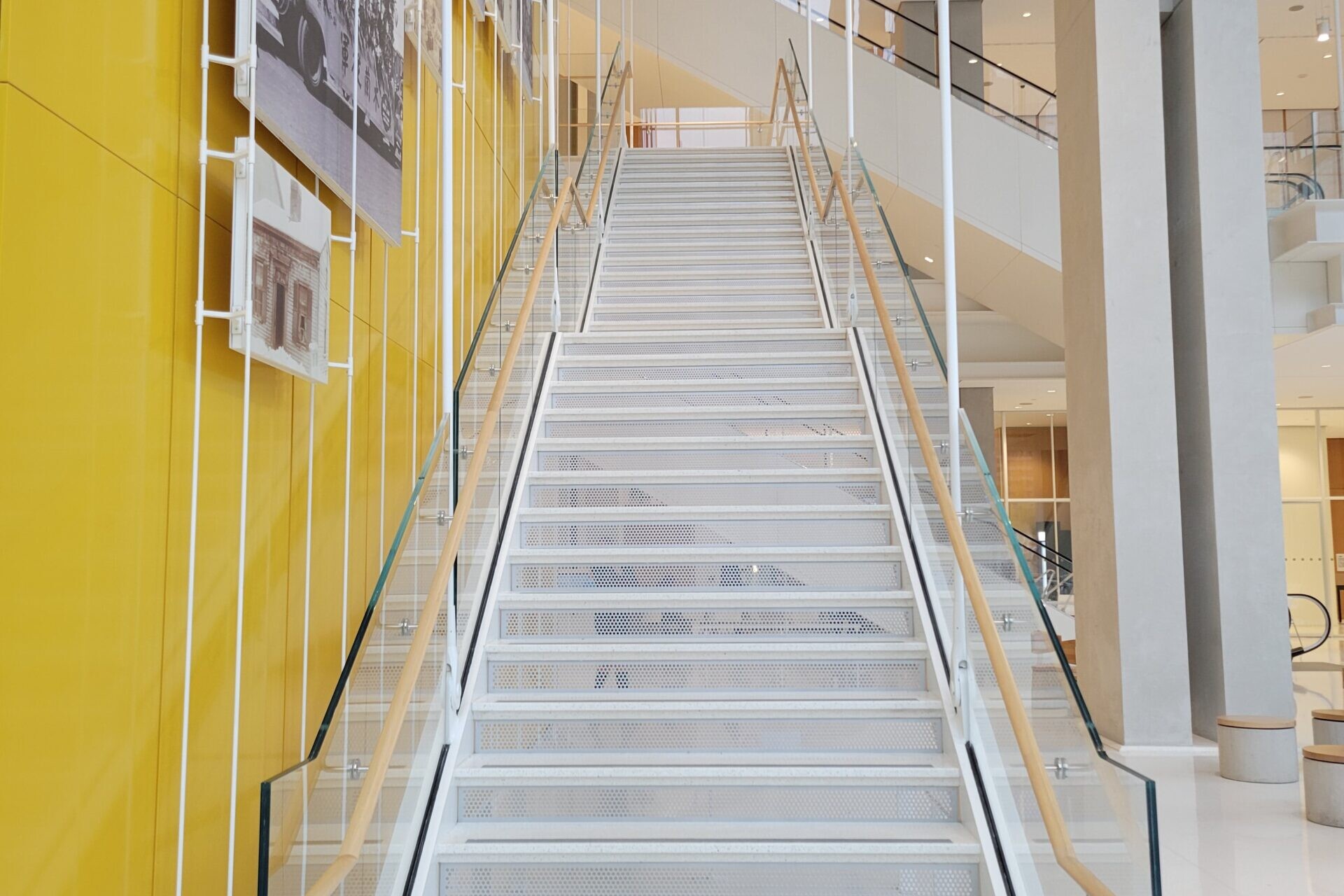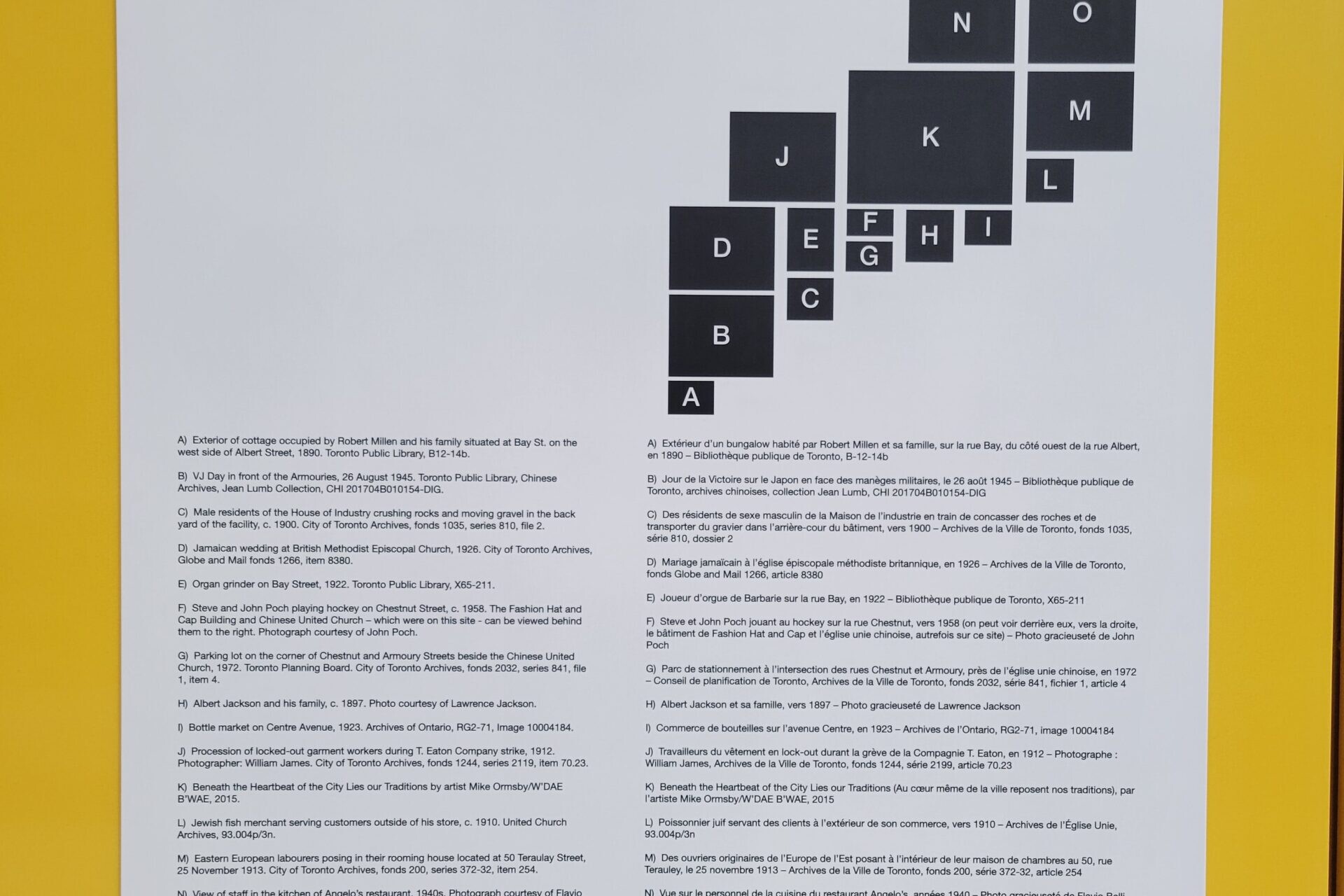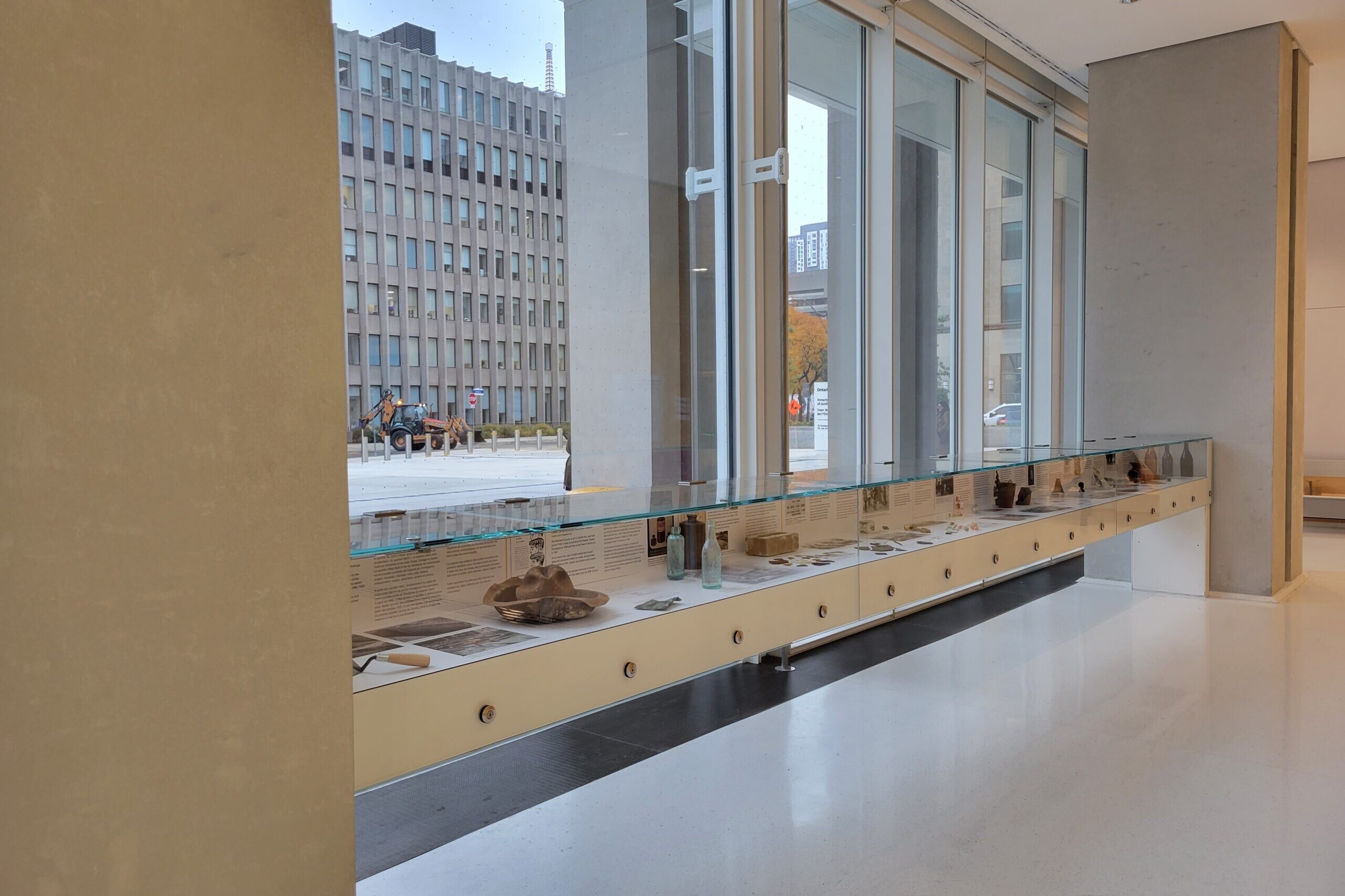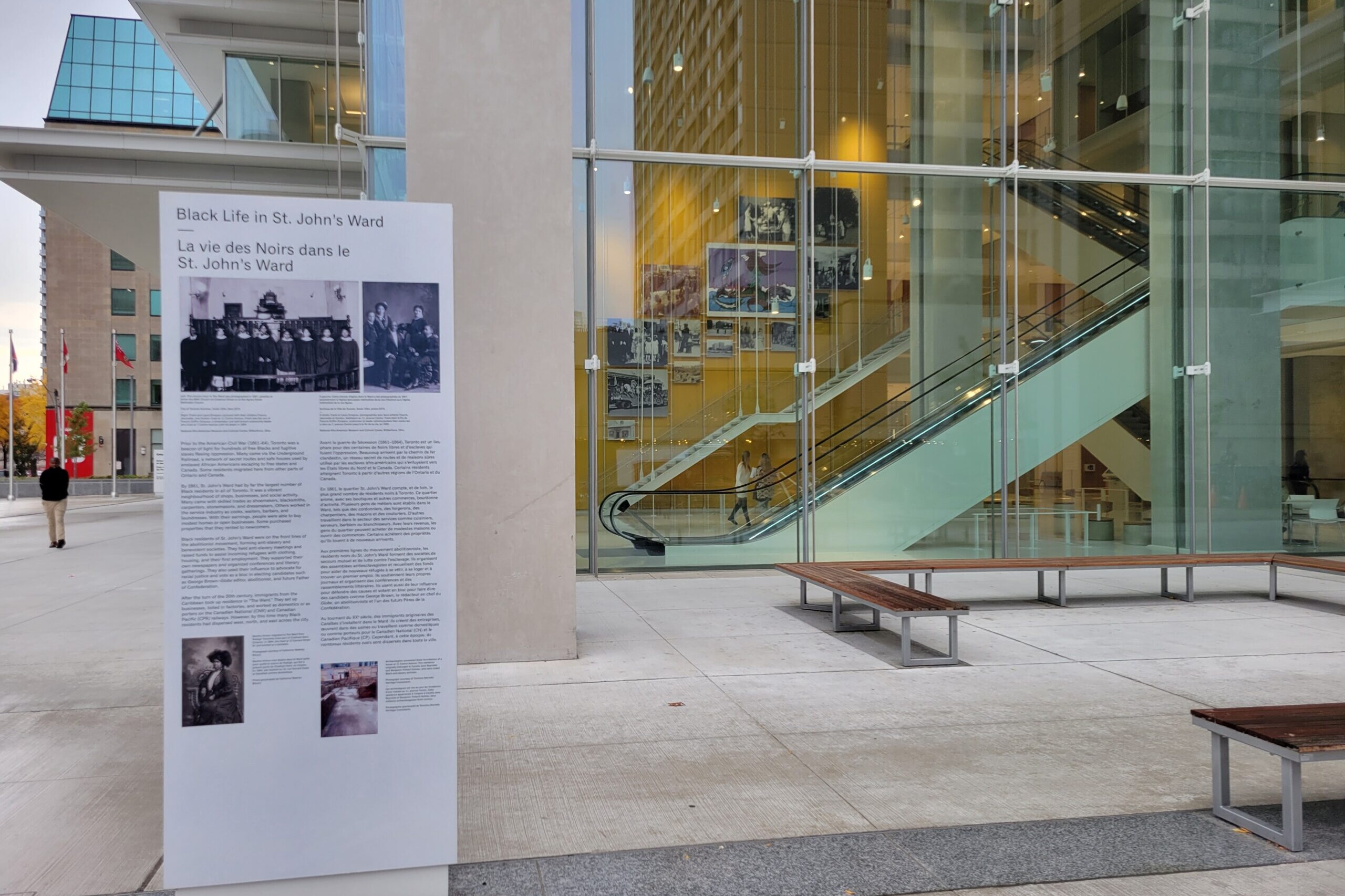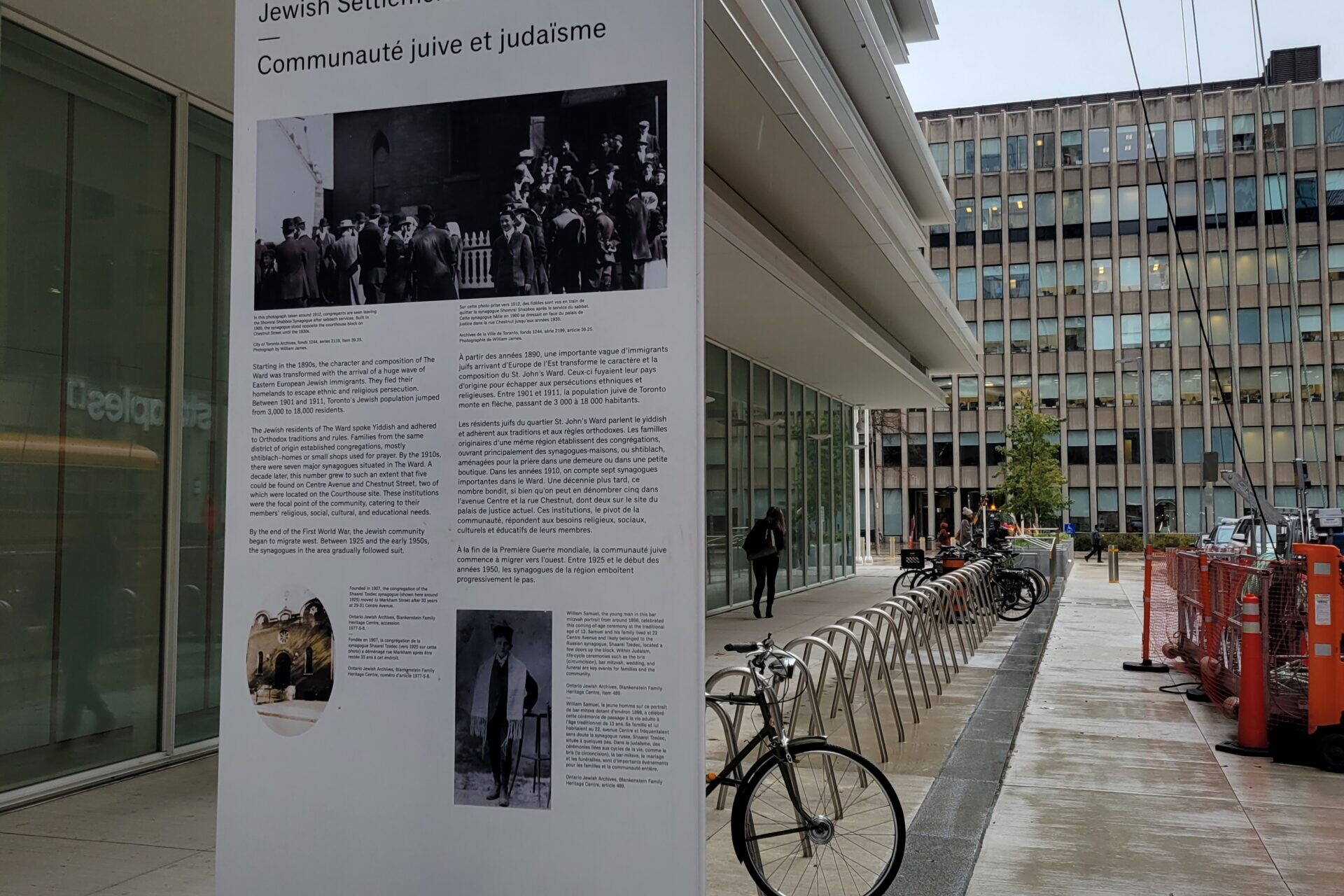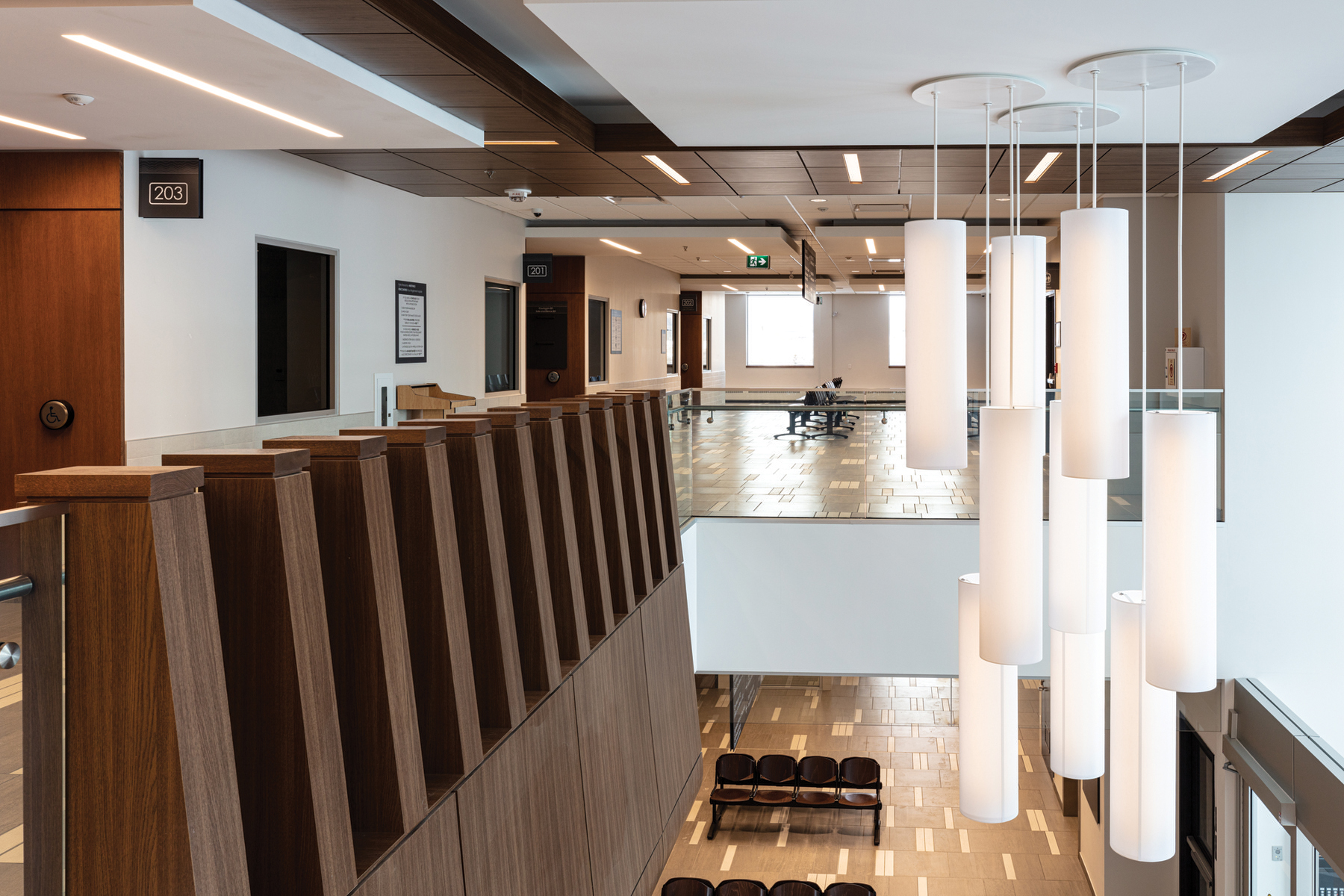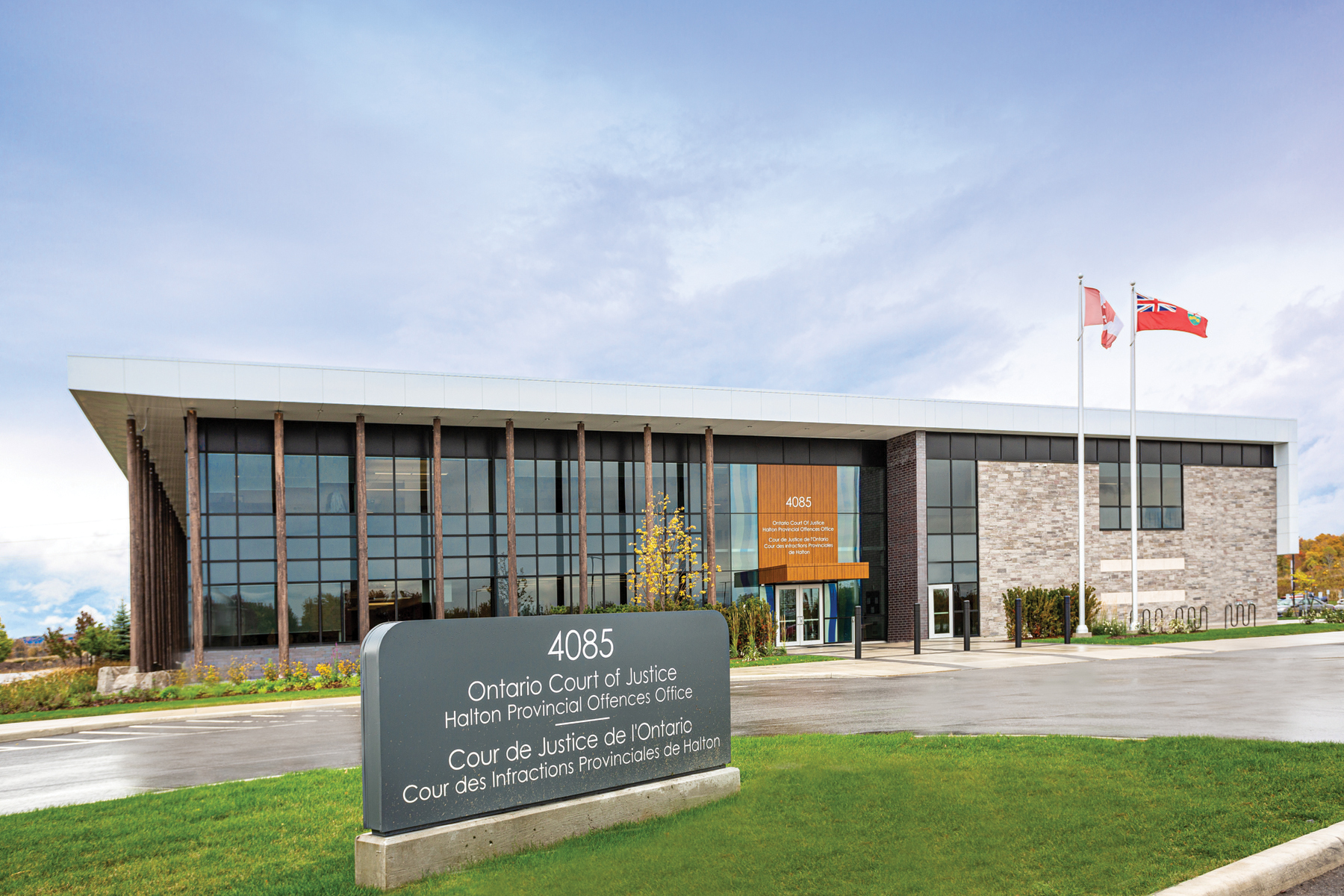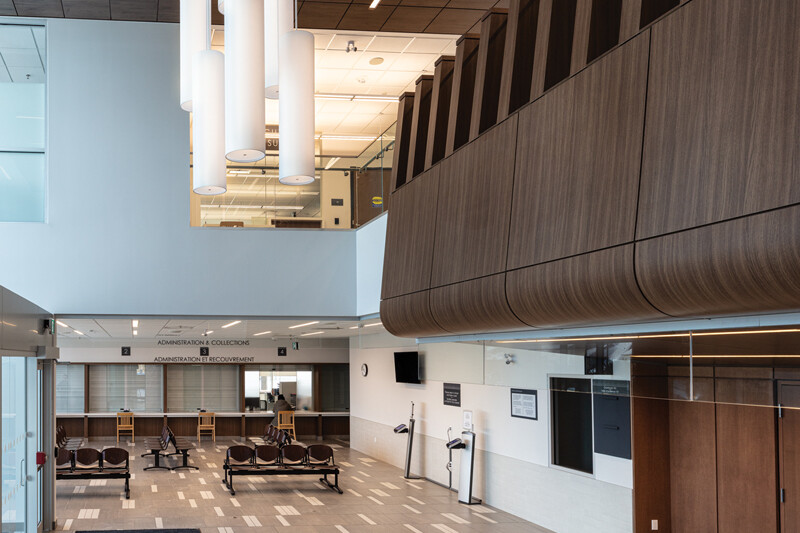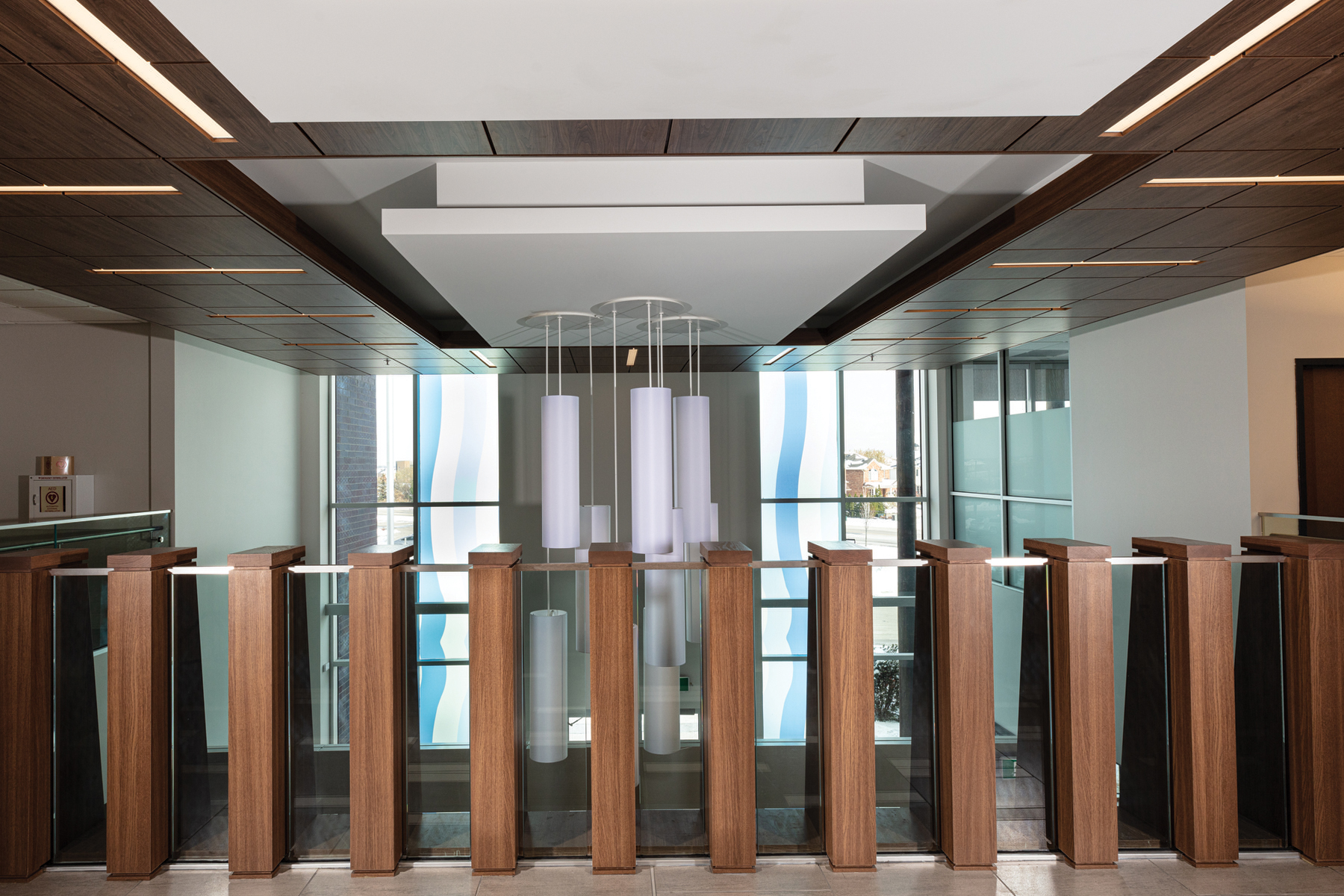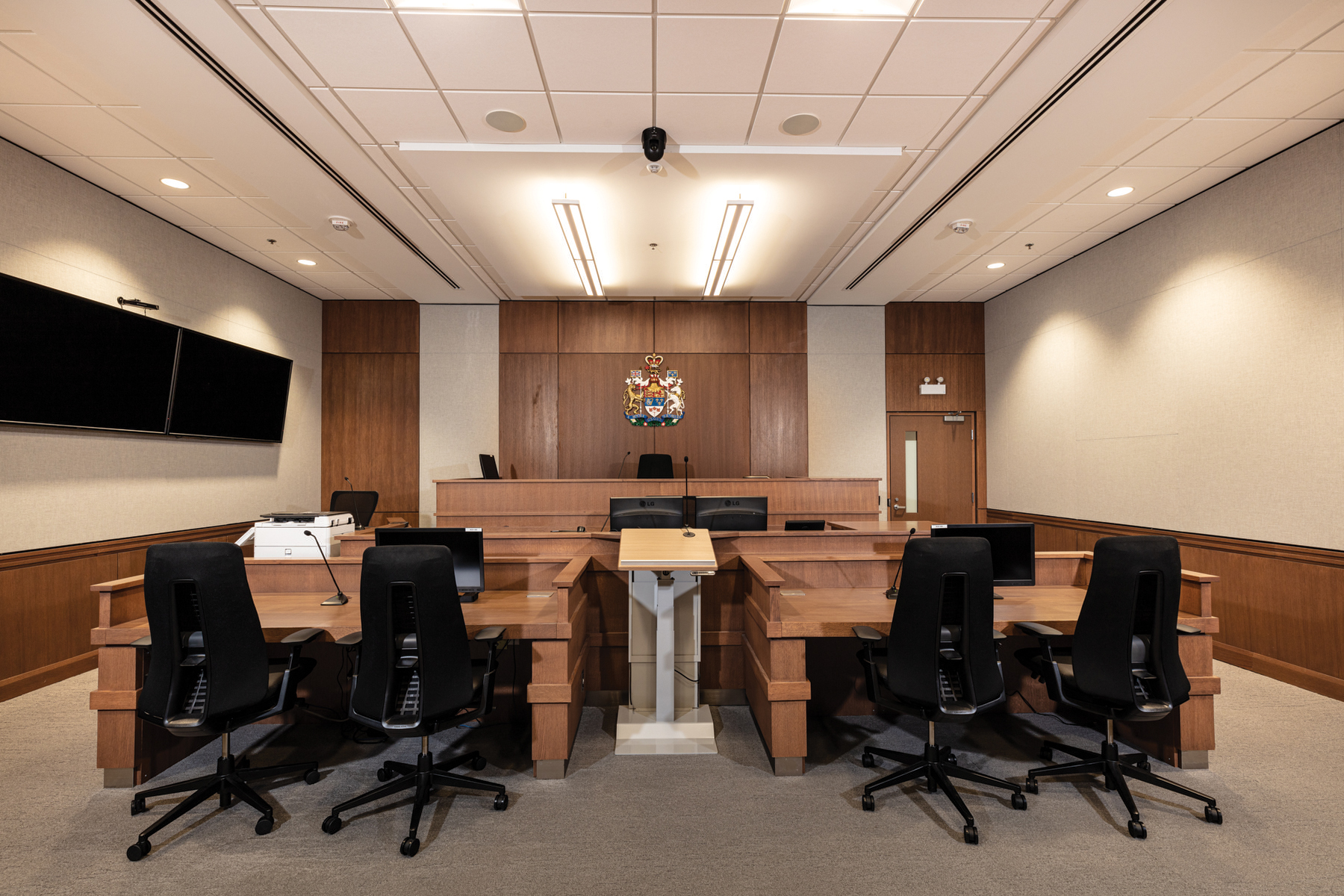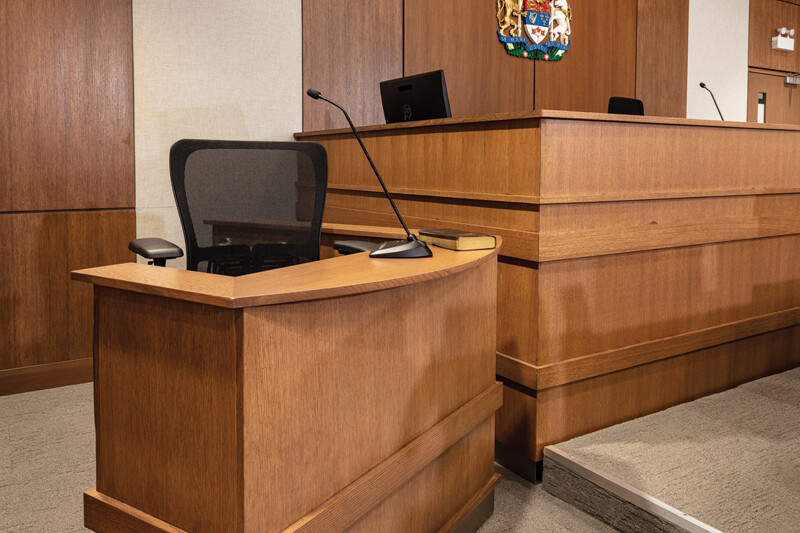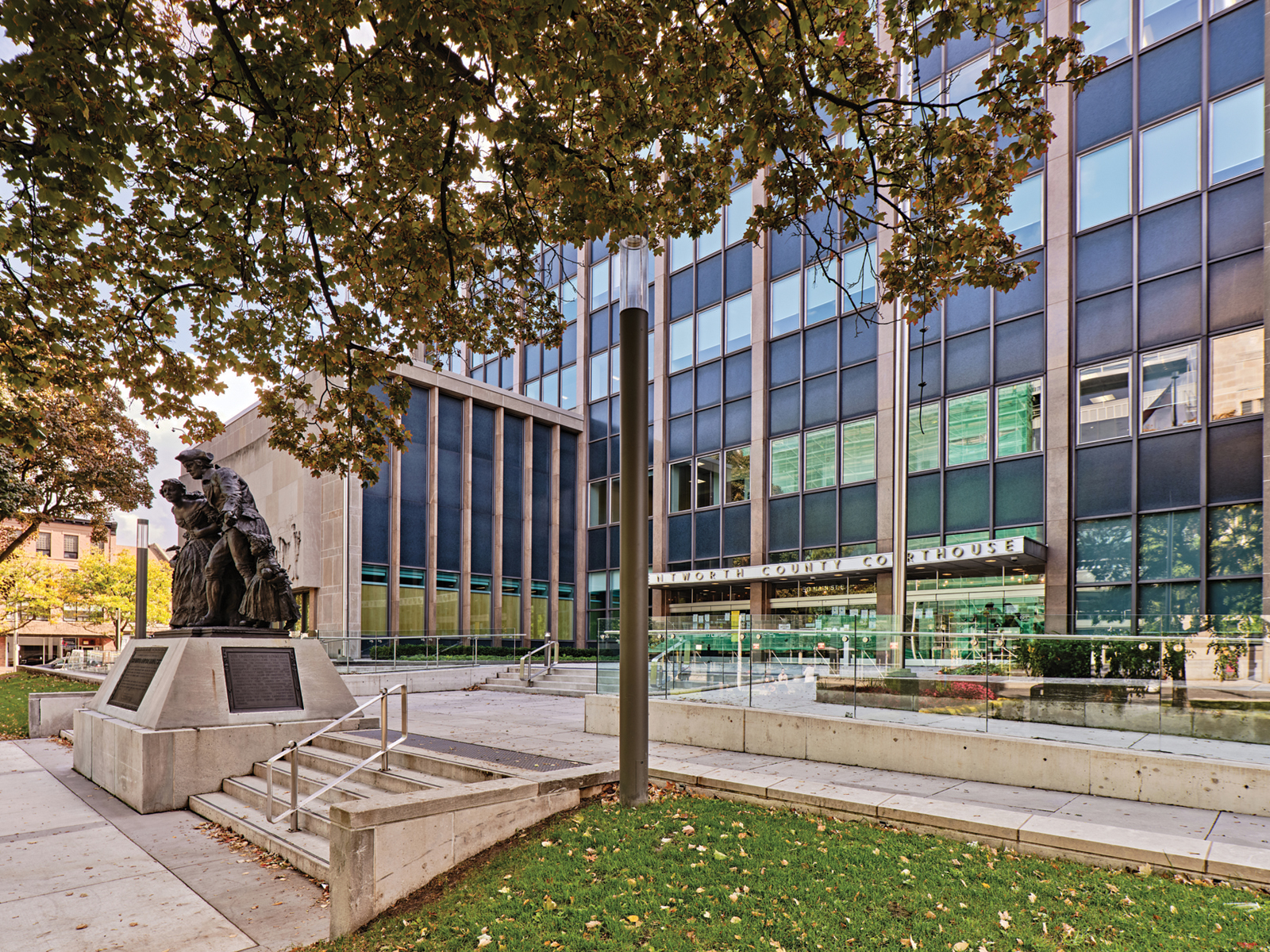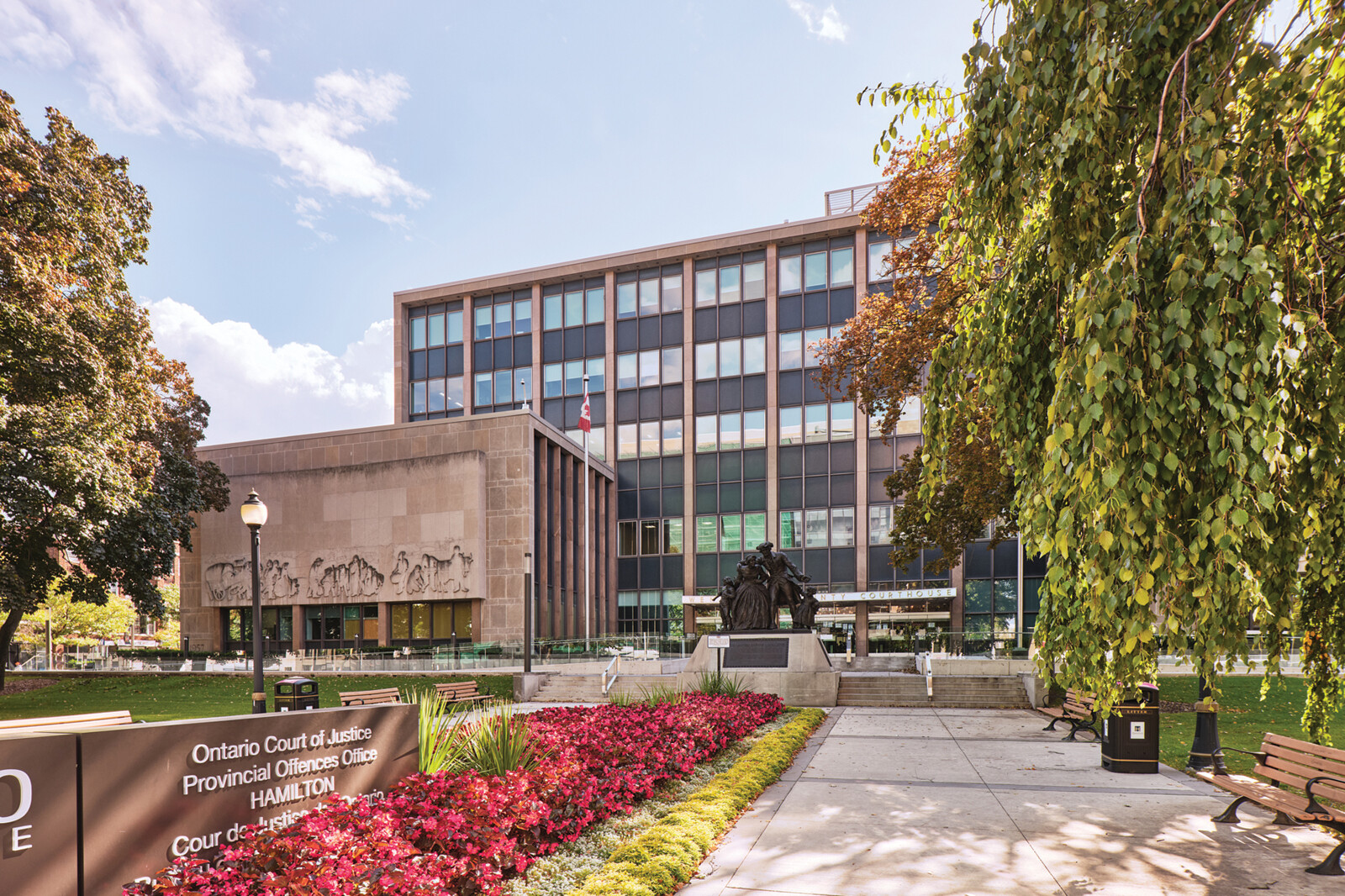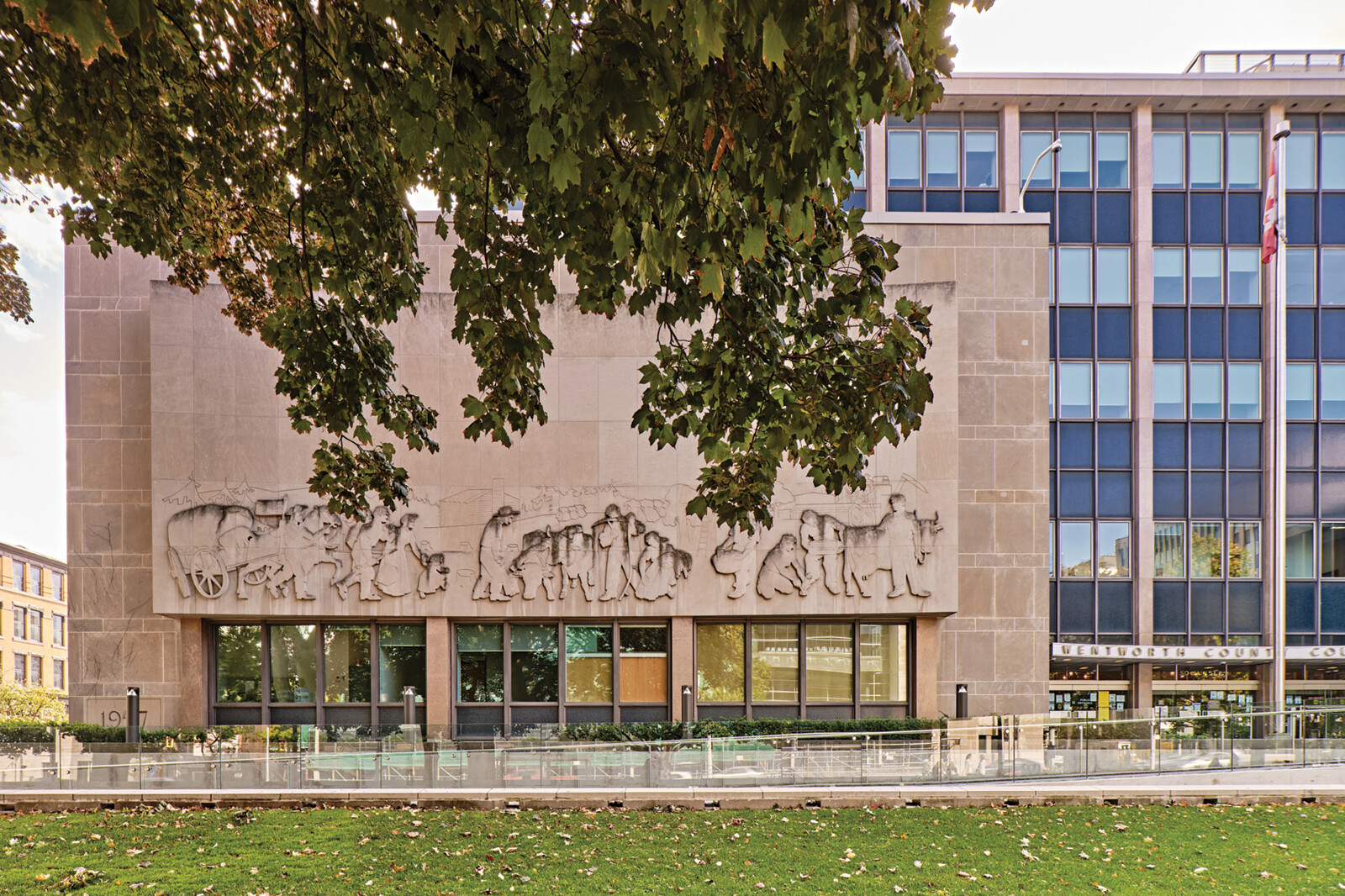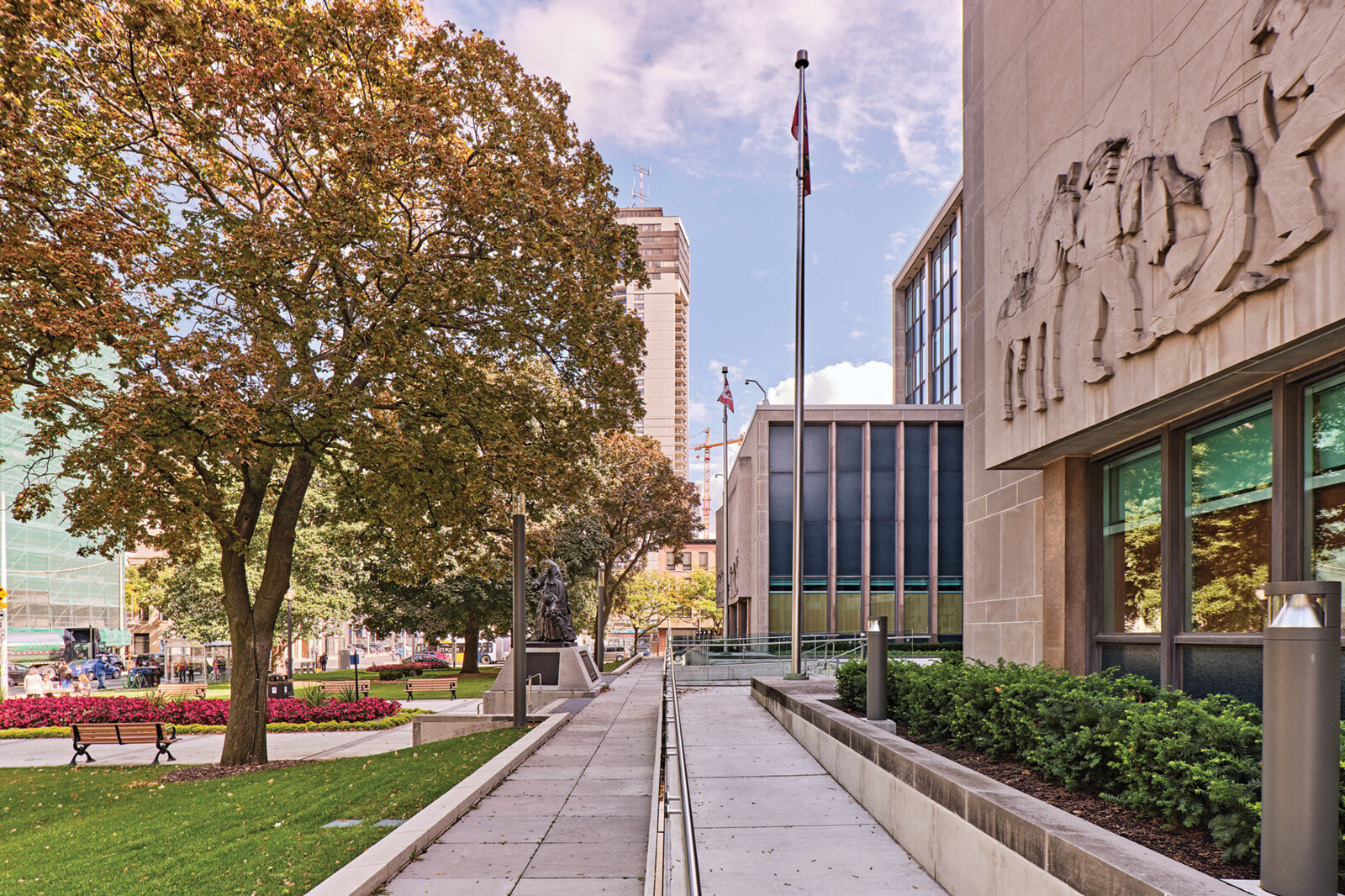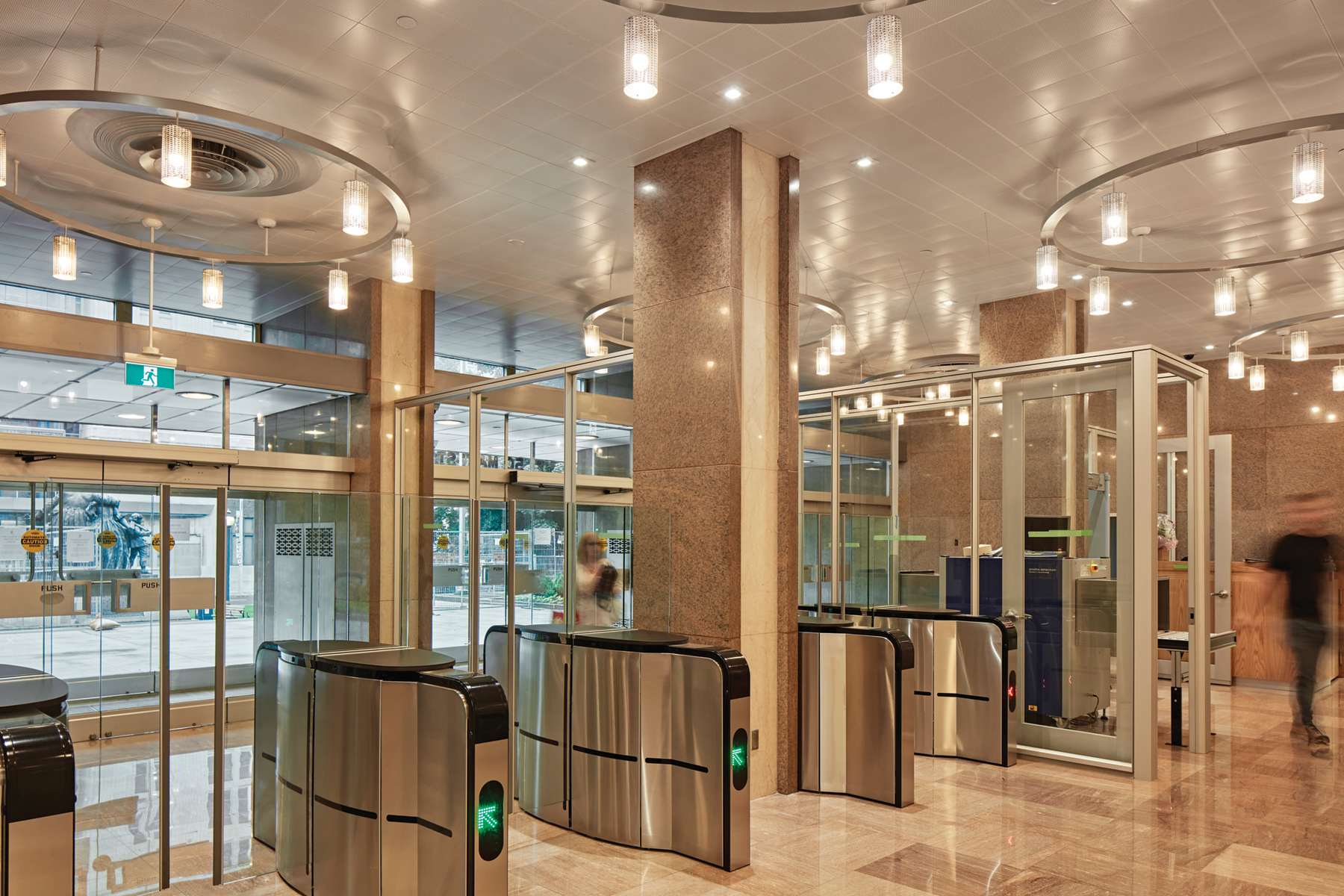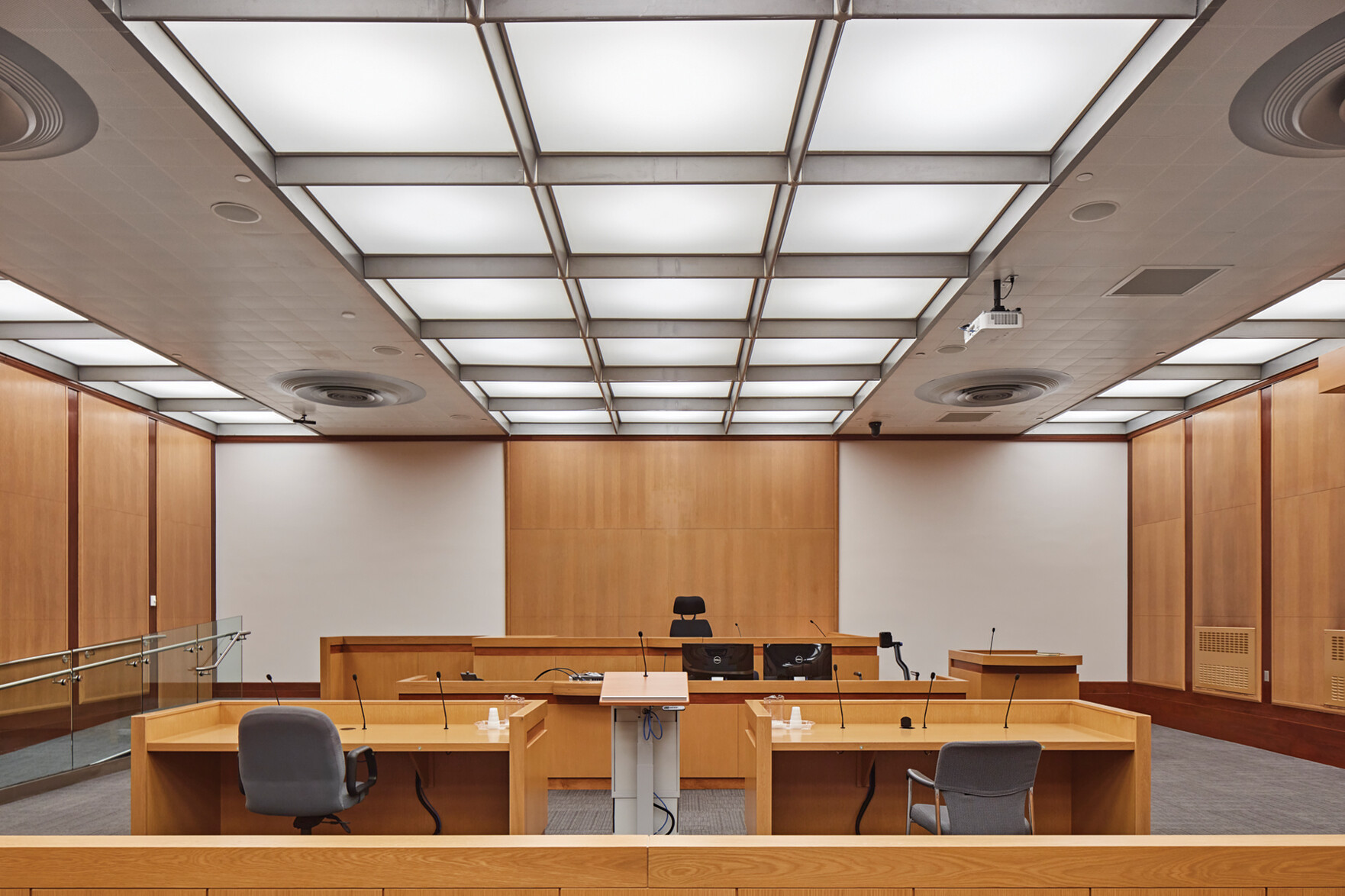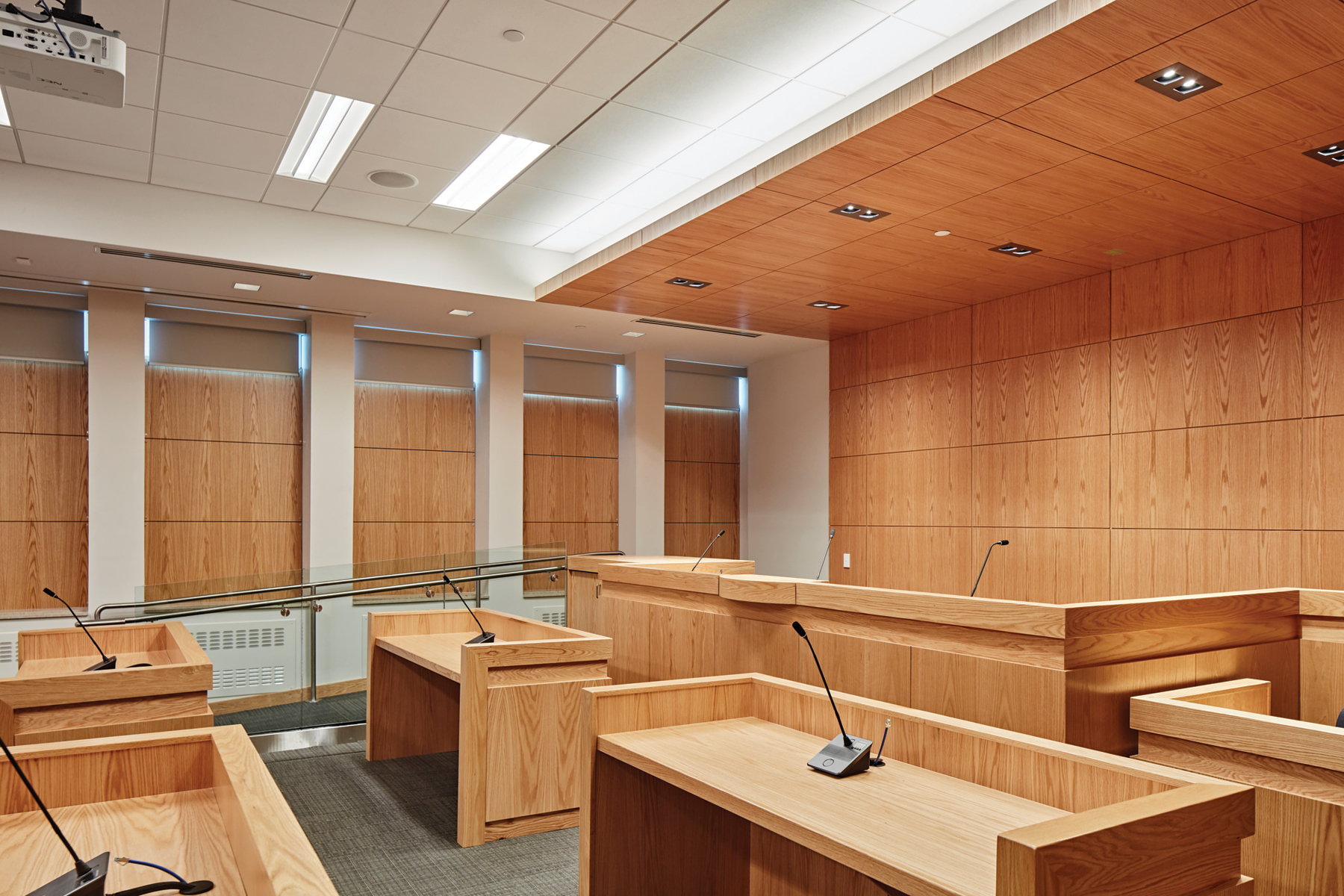Legislative Assembly of Ontario Building
The Legislative Assembly Building is the first and finest example of Richardsonian Romanesque architecture in Canada and is of national architectural and historic interest.
In 1990, a conservation plan, led by +VG Architects, was implemented over the next six years. The exterior conservation was one of the largest and most sophisticated stone conservation and roof refurbishment projects ever undertaken in Canada. The project was completed within 3% of estimates prepared at the out.set of the job.
The construction involved scaffolding of large sections of the building for each phase. The scope of the project included replacement of over an acre of slate and copper roof. It required the removal and restoration of over 600 historic wood windows, removal and replacement of all the face mortar and removing and replacement of over 17,000 cubic feet of sandstone. It also involved interior work, as the roof drainage system (cast iron risers buried in the interior walls) had to be replaced in its entirety.
Ordinarily this scale of project and type of construction work would be executed on an unoccupied building. This was not acceptable to the client and the building had to remain fully operational throughout the six year construction schedule. This challenge was compounded by the serious occupational health and safety risks involved with continuous noise, silica dust, volatile organic compounds in paints, caulking materials, lead dust from mortar removal, and pigeon droppings that constitute hazardous material. Stringent safety procedures were set-up and monitored on a continual basis.
The LAO building is presently in its fourth year of a five year masonry and window conservation program which involves analysis of previous conservation activities and continued conservative maintenance.
LOCATION
Toronto, Ontario
COMPLETED
1995-Present
SIZE
575,000 ft²
SERVICES
Conservation & Various Upgrades
AWARDS
2023 Crafts & Trades Built Heritage Award
(North Coat of Arms Conservation)
Heritage Toronto Awards
1995 Award of Merit
Heritage Toronto Awards
PRESS
Winners Announced for the 2023 Heritage Toronto Awards
Canadian Architect
Heritage Toronto Honours Architectural Excellence at 48th Annual Awards
Urban Toronto
Toronto Old City Hall
Upon completion in 1899, Toronto’s Old City Hall was the largest civic building in North America and home to government officials for 67 years during a time of intense population growth and municipal changes.
Old City Hall is the most significant building designed by architect E. J. Lennox and is the busiest courthouse in Canada, with over 10,000 people circulating within it every day.
Over the past 20 years, +VG has met the building’s challenges of intense public scrutiny and communicating with multiple stakeholder groups while executing the multi-phased conservation project. The conservation work is guided by an initial Building Condition Assessment and the Cultural Heritage Character Statement for Toronto Old City Hall.
Toronto Old City Hall ongoing work includes numerous ongoing conservation projects and building upgrades which began in 1991. Work has to be carefully scheduled to meet requirements for courtroom scheduling. +VG recently completed work on a $34 million upgrade to the building’s heating and ventilation system, introducing new systems within all spaces of the occupied courthouse, and is currently working on security upgrades at 60 Queen Street West.
LOCATION
Toronto, Ontario
CLIENT
City of Toronto
COMPLETED
1991-2015
SIZE
325,000 ft²
SERVICES
Conservation & Various Upgrades
PHOTOGRAPHY
Nicole Konrad (+VG Architects)
AWARDS
2010 North American Copper in Architecture Award
Canadian Copper & Brass Development Association
2005 Architecture & Urban Design Award (Honourable Mention)
City of Toronto
2000 Certificate of Commendation
Heritage Toronto
1996 Certificate of Commendation
Heritage Toronto
Ontario Court of Justice Toronto
The New Toronto Courthouse is a 17-storey tower courthouse that, when completed, will be the largest courthouse in Ontario. The project site has a rich history dating back to the 1840’s, with the last pre-existing building on the site having been demolished in the 1980’s. At that time heritage foundations and other elements were encapsulated under a parking lot.
In 2016, Infrastructure Ontario (IO) began an extensive Archaeological excavation of the site leading to the discovery of thousands of historical artifacts and the mapping of the lost footprints of many former buildings and structures, and the publication of two books. EllisDon retained +VG to navigate the complex approvals process with Infrastructure Ontario, the Ministry of the Attorney General (MAG), and the City of Toronto and to provide community consultation related to the heritage interpretation. +VG led consultations with:
- The Heritage Interpretation Working Group set up by the City of Toronto,
- The MAG Indigenous Elders’ Council, and
- Separate Indigenous consultation meetings with Six Nations, Huron-Wendat, and Mississaugas of the New Credit First Nation.
+VG’s challenge as the heritage architect was to provide heritage commemoration and interpretation on a site where all heritage material had been removed by the archaeological investigations or by the excavations for the courthouse. A multi-faceted heritage interpretation strategy was developed to engage the public as they approach the site and continuing through into the interior of the courthouse in the large glazed public atrium. The broad on-site Heritage Interpretation Strategy Included:
- Site hoarding with heritage interpretation and graphic displays
- Bronze inlay markers and plaques cast into the sidewalks and plaza spaces surrounding the courthouse
- Three large stainless steel interpretation signage panels in the exterior plaza
- Marker date stone and interpretative panel for the former British Methodist Episcopal Church (BME Church)
- Full scale graphic window display commemorating the façade of the BME Church at its original location
- Interior graphic explanatory panels
- Archaeological artifacts display case for rotating exhibits
- Digital information touch-screen kiosk
- Heritage wall display of historic photographs, maps, and artifacts
Extensive coordination for the Heritage Interpretation Strategy was provided by +VG with the design team: architectural, archaeological, graphic communications, landscape, and lighting. Deliverables included the Heritage Impact Assessment (HIA), Heritage Interpretation Design Plan (HIDP), and Site Plan Application approvals.
LOCATION
Toronto, Ontario
CLIENT
Infrastructure Ontario (IO)
COMPLETED
2022
SIZE
775,000 ft²
SERVICES
Heritage Consulting Services
PHOTOGRAPHY
David Ecclestone (+VG Architects)
PRESS
Renzo Piano stacks Toronto courthouse on top of massive atrium
Dezeen
T.O. courthouse integrates several facilities into one sustainable building
Construction Canada
New Courthouse in Toronto brings six courts under one roof
Canadian Architect
Excavation in Full Swing for Ontario Court of Justice
Urban Toronto
New Toronto courthouse will likely look different from others
Toronto Star
Halton Provincial Offenses Office
As the winner of a design-build competition, +VG Architects designed a POA Courthouse for the City of Burlington that was reflective of the landscape of Halton Region.
The north portion of the building is made of limestone to represent the escarpment to the north, and the south glass portion is meant to represent Lake Ontario south of the city. The landscape is further reflected within the use of repurposed telephone poles around the glass portion of the building.
While effectively giving the building an institutional feel, they are also reminiscent of the forestry of the region before urbanization and agriculture developed. The glass is highly reflective in hopes that it will almost double the look of the poles, to reinforce the environmental aspects of the region within the design. Deliverables included:
- Landscaping that was also in connection to the agrarian path. It is meant to look somewhat like an orchard or farm field, with linear organization and spatial definition. The natural environment is echoed in the design through the selection of landscape materials; tree species were selected to reflect the Carolinian typology of the region.
- Enhancements to courthouse functionality and barrier-free accessibility. Among these enhancements were the size and configuration of washrooms and holding cells for barrier-free accessibility. We included a barrier-free courthouse on the ground floor level along with a related barrier-free retiring room for a Justice of the Peace.
- The glass section, facing south, contains all the staff office areas and justice retiring rooms. The people working in these areas benefit from the abundance of natural light provided by the glass wall. The stone section, facing north, contains the police and security functions of the Courthouse as well as access to the Justice of the Peace secure parking garage, the Sally Port and incoming service rooms.
- Products and materials chosen were low maintenance and provide long-term durability. As an example, we chose to use a porcelain ceramic tile throughout the public lobby and washroom areas for these reasons. The colour scheme we chose is primarily natural, neutral colours warmed with traditional colour accents, intended to emphasize the calm and dignified proceedings that characterize the courthouse functions.
LOCATION
Burlington, Ontario
COMPLETED
2019
SIZE
34,000 ft²
SERVICES
New Construction
PRESS
Burlington POA Courthouse development helps municipalities build costly facilities
Canadian Architect
Hamilton POA Courthouse
+VG Architects served as the Prime Consultant, in association with Invizij Architects, to deliver all consulting services required for the design and construction of this renovation and energy modernization project which was performed through a Construction Management model.
The project includes the integration of a heating and cooling retrofit through the Hamilton Utility Corporation (“HUC”) designed independently by H.H. Angus and Associates Consulting Engineers. The design conforms to the City’s Barrier Free Design Guidelines.
The Art Deco building was previously occupied by McMaster University as a tenant. The project intent was to convert the heritage building to provide a functional space for the Provincial Offences Administration (POA) offices, as well as all necessary courtrooms and ancillary spaces for both staff and the public, and additional administrative offices for the Ontario Municipal Board and City of Hamilton staff, and to accommodate future growth.
Work to protect and preserve the historic elements of the building was guided by City of Hamilton Heritage Resource Management. The majority of the work focused on the interior renovation of the facility, but some exterior work was required to comply with accessibility and police vehicular turning radius requirements.
LOCATION
Hamilton, Ontario
COMPLETED
2017
SIZE
112,000 ft²
SERVICES
Renovation & Energy Modernization
PRESS
+VG Architects restores midcentury-modern courthouse in Hamilton
Canadian Architect
Hamilton to open provincial offences administration in former Wentworth County Courthouse in August
Hamilton News
Hamilton’s ‘new’ provincial offences court balancing history with $32M renovation
Hamilton Spectator

